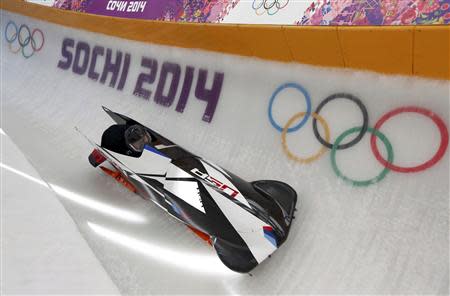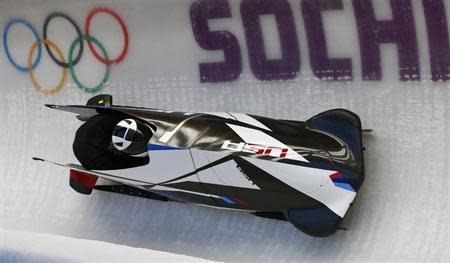F1 rivalry hots up on ice
By Alan Baldwin ROSA KHUTOR, Russia (Reuters) - Formula One technology has already helped Britain to skeleton gold at the Sochi Olympics and the bobsleigh competition will see McLaren, Ferrari and BMW take their track rivalry onto the ice as well. Like compatriot Amy Williams before her, Lizzy Yarnold's gold on Friday owed something to the assistance of McLaren Applied Technologies, part of the Formula One team's group of companies. McLaren have two employees at Sochi embedded with the skeleton and bobsleigh teams while Formula One rivals Ferrari have been leaning on their boffins and using track-honed know-how to help the Italians. Over the last two years, BMW - who quit Formula One in 2009 - have also worked closely with coaches, athletes and engineers of the USA Bobsled and Skeleton Federation to completely redesign their two-man bobsled. McLaren Applied Technologies director of performance Caroline Hargrove said her experts had worked on Yarnold's sled for several years, although exact details were as jealously guarded as anything coming out of the F1 factory. "We got involved after the last Olympics so that sled had already been started and been very successful with Amy Williams (winner in 2010) and we got involved in doing the second set of tweaks and improvements," she told Reuters by telephone. The main areas in which McLaren's expertise can be harnessed tend to be in aerodynamics, sled dynamics and technical setup and the gains have been incremental rather than dramatic. Components have been rebuilt and refined for maximum performance, while data gleaned since Vancouver has been processed and applied. In skeleton, one size does not fit all. "In each case we personalize the intervention, so for example the sled dynamics are tailored to the particular athlete," said Hargrove. "If you look at Lizzy and you look at Amy Williams, they are very different athletes. They are 20 kilos different. "You need something personalized. And we spend a lot of time doing that. So we got performance out of personalizing to the athletes." With Yarnold, the sled was improved as she did got better. "She ... is an extremely talented athlete and therefore changes that we made to the sled that she liked, she took on board," said Hargrove. "It made a difference but at the same time it made her a better skeleton athlete. "We've never seen anyone really learn so quickly. Which means that the sled must be good or better than the previous ones in order to get to your high level quicker." Hargrove said McLaren could take a pat on the back for Yarnold's performance, but no more than that. Most of it was all down to the athlete. "We're pleased if we made a sled that she feels comfortable with and therefore can perform really well," she said. SERIOUS FUN Yarnold was a favorite in skeleton but the bobsleigh offers a different challenge and the rivalry between Ferrari and McLaren can best be described as 'serious fun'. "We like that," Hargrove said of the rivalry. "It's part of how we are. Everyone working here is seriously competitive and the same on their side. So it adds another element to it, which is quite fun. It's not more than fun. "In winter sport, they are in a different position. They have tracks themselves, they are a winter sport nation with snow and mountains - something we haven't got. "So we have needed to be at times a little bit more creative in the ways that we could support the team because we haven't got that and never will have a track." There has been some work in simulation and the wind tunnel, although in Southampton rather than the one used by the Formula One team due to the costs involved. Bobsleigh, like Formula One, has tightly defined rules and materials to be used, which makes the scope for finding a big chunk of time on the ice is limited. But components have been rebuilt and refined. "Once the competition starts, a bit like Formula One, there's not that much you can do," said Hargrove. "The sleds get inspected and then go into parc ferme overnight. "But before that, while they were testing, to make sure they had the best setup for the conditions, we were there to help." (Editing by Peter Rutherford)


